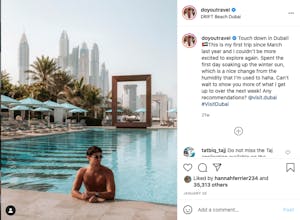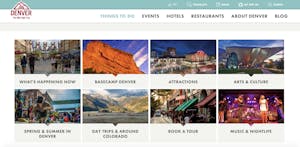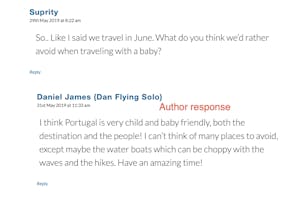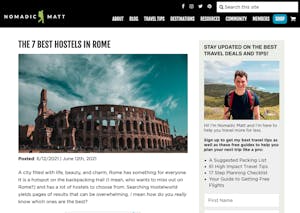- 13 minute read
- Business Management Tips
- Local Strategies
- SEO
All Skill Levels
Get a behind-the-scenes-look into FareHarbor's 2024 season

When it comes to your content strategy, you’re doing everything right: conducting keyword research, writing evergreen content, and performing regular content audits. But your content still isn’t earning backlinks. What’s going on?
No matter your industry, you’re going to encounter fierce competition on the SERP. Everyone wants natural, quality backlinks that occur organically. If you’ve put in the work to write useful content that thoroughly answers the questions being asked by your target audience, your quest for backlinks isn’t over yet.
Your great content might be outperformed by another website simply because it wasn’t marketed to the fullest. It’s like the old question: If a tree falls in the forest, does it make a sound? If a piece of high-quality content is published on the web, but nobody links to it, does it help your overall content strategy? Probably not as much as it could.
Learn how to make your content go the extra mile with these 6 tips.

There’s some controversy over whether or not it’s worth it to work with influencers. But when you get a person who is well-known in your niche to link to your content, you don’t just form a relationship with that person but with their entire audience as well. And when you consider the fact that Gen Zers and Millennials travel more than any other generation, it might make sense to jump on the influencer bandwagon.
72% of Gen Zers and Millennials follow an influencer (Morning Consult).
Now, this doesn’t mean you have to start giving away freebies to all of your social media connections. But if you know of any travel influencers in your area, reach out and invite them to take a tour, especially if they fit your target audience demographic. You can entice them by offering a discount, letting them join a group tour for free, or offering to give them a shout out on social media.
We’ve always been big proponents of working with other businesses in your area to boost your local SEO strategy. If you’re friendly with any other business owners near you, consider reaching out and asking to write a guest blog on their website (or having them write one on yours!). Link to each other’s content and foster a great relationship that could create even more content opportunities in the future.

Let’s say you’re visiting Denver, Colorado, and you’ve booked a tour with a white water rafting company. You have to drive a couple of hours out of the city for the tour, and you want to make a day of it by grabbing lunch at a local restaurant and visiting other area attractions while you’re outside of the city. Wouldn’t it be great if you could find all the best spots to visit right on the website where you booked your tour?
Resource pages are the ultimate way to get users to stay on your website, and they show off your expertise about your area. Create a page that links to blog posts you’ve written about things to do in your area, nearby restaurants, family-friendly attractions, and tips for getting around. In some cases, your resource page will include content you’ve already written. But you should also add links to local businesses and reach out to ask them to share your content in return.
Make your resource page even more shareable by using great images. Share the resource page in an email newsletter and on social media. Don’t forget to keep updating the page with new places to visit or things to do nearby.
Nobody wants to read a giant wall of text, even if it contains the exact answer to their query. Break up your content with:
When it comes to adding visuals, think outside the box.
Articles containing images receive 94% more views compared to those that don’t include images (Widen).
Photos are a good starting point, but try to level up with infographics, data visualization, videos, and even memes or GIFs.

Whether your blog platform supports commenting or you’re getting comments on your social media posts, set aside some time to respond to every single one.
On social media, replying to comments keeps your post fresh and boosts it to the top of your followers’ newsfeeds, especially if the initial poster responds again. On blog posts, an active comments section shows readers that you and your audience are engaged in conversation. This could really come in handy when asking other websites to link to your content.
 Pro tip: Leave helpful or thoughtful comments on other blog posts or social media pages to foster communication in your niche. You never know what connections you might make that can lead to even more content sharing opportunities.
Pro tip: Leave helpful or thoughtful comments on other blog posts or social media pages to foster communication in your niche. You never know what connections you might make that can lead to even more content sharing opportunities.

List posts are the most shared type of content on social media (BuzzSumo).
People love to see quick, actionable tips in an easy-to-read format. List posts are typically characterized by a title like 7 must-do activities near the Grand Canyon or 12 ways to travel on a budget.
These easily scannable posts are perfect for blogs, but you can also use this format to refresh some of your website content or even share a list in the format of an Instagram carousel.
Finally, if you’re trying to get lots of shares for your content, ask yourself the hard question: would you link to your piece of content? If not, it’s time to spend more energy on writing amazing content before you dive into link building outreach.
Remember, as with all things SEO/content, gaining quality backlinks and social shares takes time. Keep updating your content and see your digital presence grow.